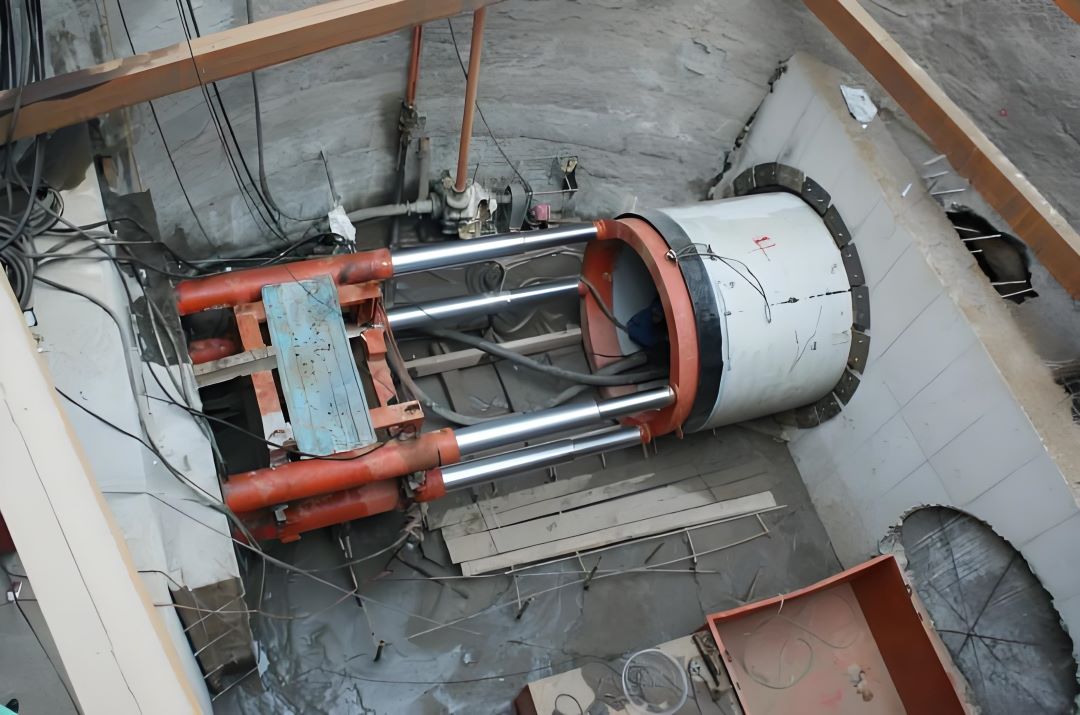What is a pipe jacking machine? A pipe jacking machine is a specialized piece of engineering machinery used for trenchless underground pipeline construction. Its core function is to jack pipes (such as sewage pipes, gas pipes, and cable protection pipes) from a launch well (or working well) to a receiving well without excavating the ground, thereby laying or repairing underground pipelines. Because it minimizes impact on surface traffic, surrounding buildings, and the environment, it has become a key piece of equipment in urban underground engineering construction. The following is a detailed introduction from various aspects:

I. Core Working Principle of a Pipe Jacking Machine
The construction process of a pipe jacking machine can be summarized as "jacking - cutting - soil discharge - guiding":
1. Jacking Power: A jack (jacking system) in the working pit provides axial thrust, propelling the pipe and the main machine forward;
2. Soil Excavation: The cutting mechanism (such as the cutterhead or tool) at the front of the main machine breaks or cuts the soil in front, creating a construction space;
3. Soil Discharge: The removed soil (or mud) is discharged to the surface using equipment such as screw conveyors and slurry pipes;
4. Precision Guidance: Laser guides, total stations, and other equipment monitor the machine's position in real time, and the corrective cylinder adjusts the direction to ensure that the pipe is advanced along the designed axis.
II. Main Classifications of Pipe Jacking Machines
Pipe jacking machines are generally classified based on their "excavation face balancing method" (controlling the excavation face's stability to prevent collapse or water inrush). Common types include:
1. Earth Pressure Balance Pipe Jacking Machine (EPB)
① Principle: Balances the water and soil pressures of the excavation face by controlling the earth pressure in the "soil chamber" within the main machine (earth pressure = active earth pressure at the excavation face + groundwater pressure);
② Applicable Geology: Soft soils, silty clay, sandy soils, etc. (strata with moderate water content);
③ Advantages: Discharged soil is dry or semi-dry, resulting in minimal pollution and suitable for sensitive urban areas.
2. Slurry Balance Pipe Jacking (SLS)
① Principle: Specialized slurry is injected into the soil silo, forming a "slurry membrane" to balance the pressure on the excavation surface. Simultaneously, the slurry carries the excavated soil through a pipe.
② Applicable Geology: High-water-table strata, sandy and gravel layers, soft soils, etc. (especially suitable for water-rich strata).
③ Advantages: High excavation surface stability and high-precision control of surrounding settlement, but mud contamination must be addressed.
3. Hand-excavated Pipe Jacking
① Principle: Manual excavation of the soil ahead, relying on manual control of the excavation surface (requiring dewatering or support).
② Applicable Geology: Geologically stable clay soils without groundwater.
③ Features: Low cost, but low efficiency and poor safety, gradually being replaced by mechanical methods.
4. Micro Pipe Jacking Machine/Directional Drill
Principle: Miniaturized design, using water drilling or hydraulic jacking, flexible and efficient;
Applicable to: Small cable pipes with a diameter of ≤1 meter, rural water/gas pipelines;
5. Rectangular Pipe Jacking Machine
Principle: With a rectangular cross-section, it is suitable for large-section construction such as integrated pipe corridors and subway entrances and exits;
Applicable to: Underground passages and pipe corridor projects;
6. Other Special Types
① Rock Pipe Jacking Machine: Equipped with a cutterhead, suitable for hard rock formations (such as quartzite and granite);
② Air Pressure Balanced Pipe Jacking Machine: Injects compressed air into the soil chamber to balance pressure, suitable for formations with high water pressure and high permeability;
III. Core Components of a Pipe Jacking Machine
A pipe jacking machine is a complex device integrating multiple systems, primarily consisting of the following components:
① Main Unit: Contains the cutting mechanism (cutterhead, cutters), drive system (hydraulic motor or electric motor), soil chamber (for pressure balance), and a guide cylinder (for directional adjustment);
② Jacking System: Jacks (provide thrust), back wall (bears reaction force), guide rails (supports pipes and mainframe);
③ Soil Discharge System: Screw conveyor (for earth pressure balance), slurry pump and pipes (for slurry balance);
④ Guidance System: Laser transmitter, receiving target, attitude sensor (real-time position and angle monitoring);
⑤ Auxiliary Systems: Grouting system (injects lubricating slurry into the outer wall of the pipe to reduce jacking resistance), hydraulic system (drives various components), electrical control system (integrated operation and monitoring).
IV. Applicable Applications
The core advantage of pipe jacking is its trenchless nature, making it widely used in applications requiring protection of the surface environment:
1. Urban underground pipeline construction: Laying sewage, stormwater, gas, and heating pipes, etc., to avoid excavating main roads and disrupting traffic.
2. Crossing sensitive areas: Crossing railways, highways, rivers, airport runways, and beneath historic buildings, minimizing interference with existing infrastructure.
3. Complex terrain construction: Operating in areas with soft soil, high water levels, and karst areas, where traditional excavation is difficult.
4. Underground pipeline corridors and tunnels: Used for the concealed excavation of integrated pipeline corridors and small tunnels (such as subway connecting passages).
The pipe jacking machine is a core piece of modern trenchless technology for underground engineering. Its development has promoted the efficient and safe construction of urban pipeline networks, tunnels, and other projects. As technology evolves, it will play a more important role in complex geological conditions and large-scale projects, becoming a key support for the construction of "underground cities."





